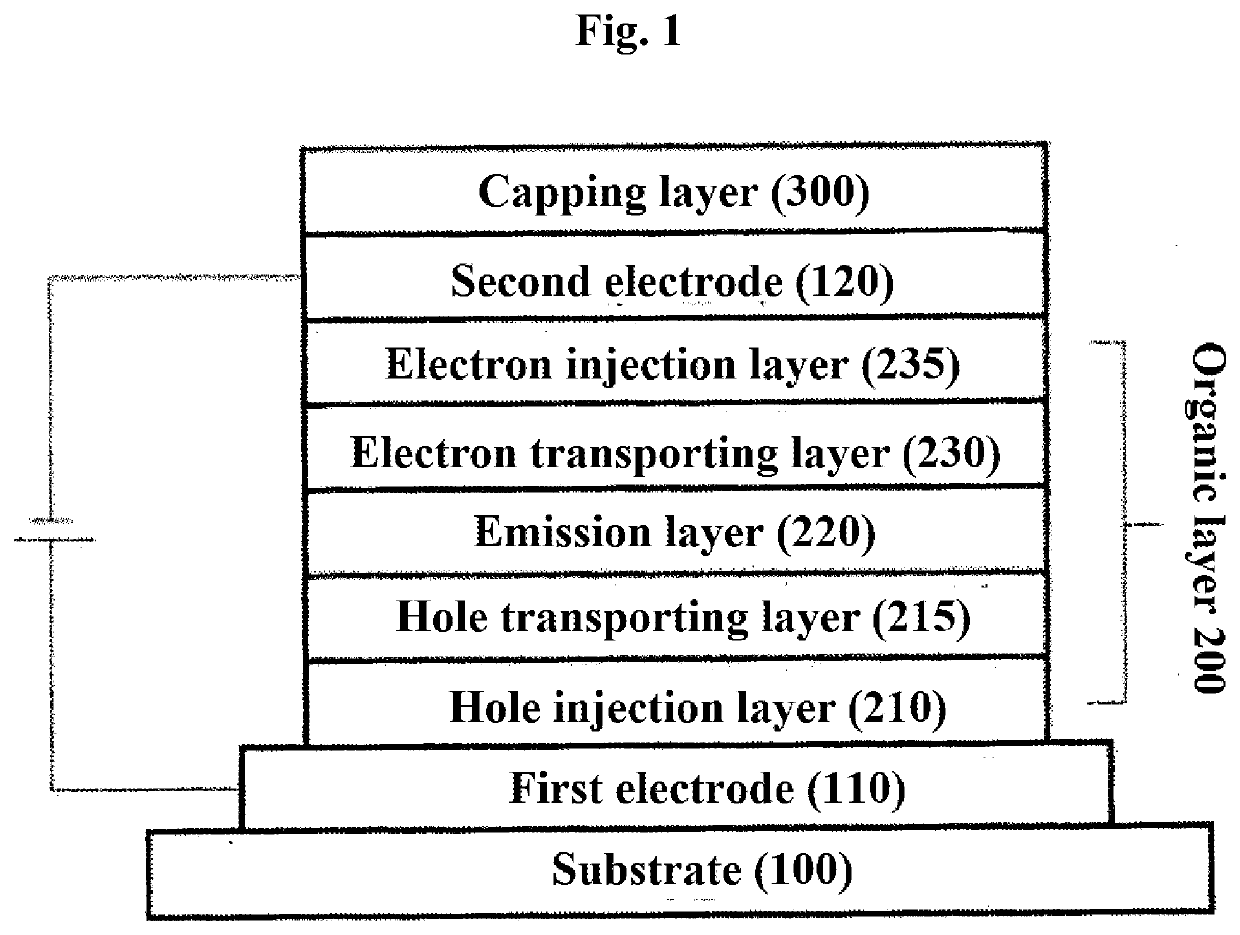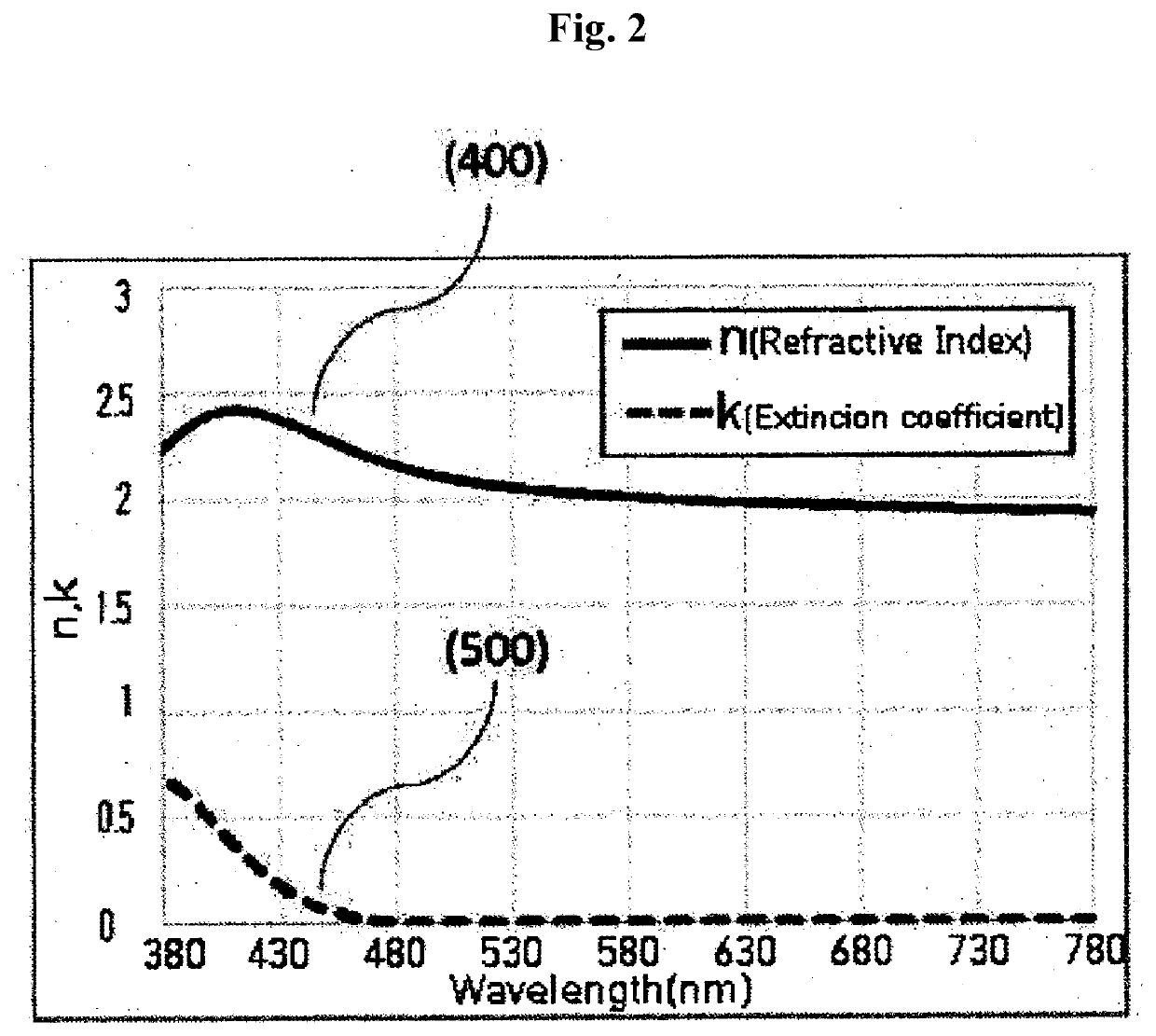Tribenzazole amine derivative and organic electroluminescent device comprising same
a technology of tribenzazole amine and organic electroluminescent devices, which is applied in the direction of solid-state devices, semiconductor devices, organic chemistry, etc., can solve the problems of affecting the composition of organic materials, requiring additional light sources, and limited viewing angle of liquid crystal displays (lcds), so as to improve light efficiency, maintain the inherent efficiency and lifetime of organic electroluminescent devices, and minimize damage to organic materials
- Summary
- Abstract
- Description
- Claims
- Application Information
AI Technical Summary
Benefits of technology
Problems solved by technology
Method used
Image
Examples
synthesis example 1
ediate 3
[0094]
Synthesis of Intermediate 2
[0095]10.0 g (0.09 mol) of 2-aminophenol, 16.9 g (0.09 mol) of 4-bromobenzaldehyde, and 114 mL of ethanol were stirred at room temperature for 6 h. After completion of the reaction, the solvent was distilled off under reduced pressure, followed by drying to afford crude Intermediate 1. Intermediate 1 was used for the subsequent reaction without further purification.
[0096]Intermediate 1 was dissolved in 370 mL of dichloromethane, and then 22.8 g (0.10 mol) of 2,3-dichloro-5,6-dicyano-p-benzoquinone (DDQ) was slowly added thereto with stirring at room temperature. After stirring for one day, the reaction mixture was purified by column chromatography (DCM) and solidified with methanol to afford 30.5 g (yield 94.4%) of Intermediate 2 as a white solid.
Synthesis of Intermediate 3
[0097]10.0 g (36.50 mmol) of Intermediate 2, 7.9 g (43.80 mmol) of benzophenone imine, and 243 mL of toluene were placed in a 1000 mL one-neck flask, and then 1.1 g (1.82 m...
synthesis example 2
ediate 6
[0098]
Synthesis of Intermediate 5
[0099]10.0 g (76.88 mmol) of 2-aminobenzothiol, 12.8 g (69.42 mol) of 4-bromobenzaldehyde, and 130 mL of ethanol were stirred at room temperature for 6 h. After completion of the reaction, the solvent was distilled off under reduced pressure, followed by drying to afford crude Intermediate 4. Intermediate 4 was used for the subsequent reaction without further purification.
[0100]Intermediate 4 was dissolved in 320 mL of dichloromethane, and then 19.9 g (0.09 mol) of 2,3-dichloro-5,6-dicyano-p-benzoquinone (DDQ) was slowly added thereto with stirring at room temperature. After stirring for one day, the reaction mixture was purified by column chromatography (DCM) and solidified with methanol to afford 26.6 g (yield 90.2%) of Intermediate 5 as a white solid.
Synthesis of Intermediate 6
[0101]26.6 g (91.67 mmol) of Intermediate 5, 19.9 g (110.00 mmol) of benzophenone imine, and 270 mL of toluene were placed in a 1000 mL one-neck flask, and then 2.6 ...
synthesis example 3
ediate 9
[0102]
Synthesis of Intermediate 8
[0103]25.0 g (203.00 mmol) of 2-amino-4-methylphenol, 45.1 g (243.60 mmol) of 4-bromobenzaldehyde, and 812 mL of ethanol were stirred in a 2000 mL one-neck flask at 80° C. for 3 h. After completion of the reaction, the reaction mixture was cooled to room temperature and distilled under reduced pressure to remove the solvent. The precipitated solid was dried under vacuum for 4 h to afford 58.9 g of Intermediate 7 as a brown solid. Intermediate 4 was used for the subsequent reaction without further purification.
[0104]58.9 g (202.90 mmol) of Intermediate 7 and 1015 mL of dichloromethane were stirred in a 2000 mL one-neck flask at room temperature.
[0105]To the mixture was slowly added 55.3 g (243.60 mmol) of 2,3-dichloro-5,6-dicyano-p-benzoquinone (DDQ) at room temperature. The resulting mixture was stirred all day. After completion of the reaction, the reaction mixture was filtered through a pad of celite using DCM and distilled under reduced pr...
PUM
| Property | Measurement | Unit |
|---|---|---|
| energy band gap | aaaaa | aaaaa |
| temperature | aaaaa | aaaaa |
| temperature | aaaaa | aaaaa |
Abstract
Description
Claims
Application Information
 Login to View More
Login to View More - R&D
- Intellectual Property
- Life Sciences
- Materials
- Tech Scout
- Unparalleled Data Quality
- Higher Quality Content
- 60% Fewer Hallucinations
Browse by: Latest US Patents, China's latest patents, Technical Efficacy Thesaurus, Application Domain, Technology Topic, Popular Technical Reports.
© 2025 PatSnap. All rights reserved.Legal|Privacy policy|Modern Slavery Act Transparency Statement|Sitemap|About US| Contact US: help@patsnap.com



